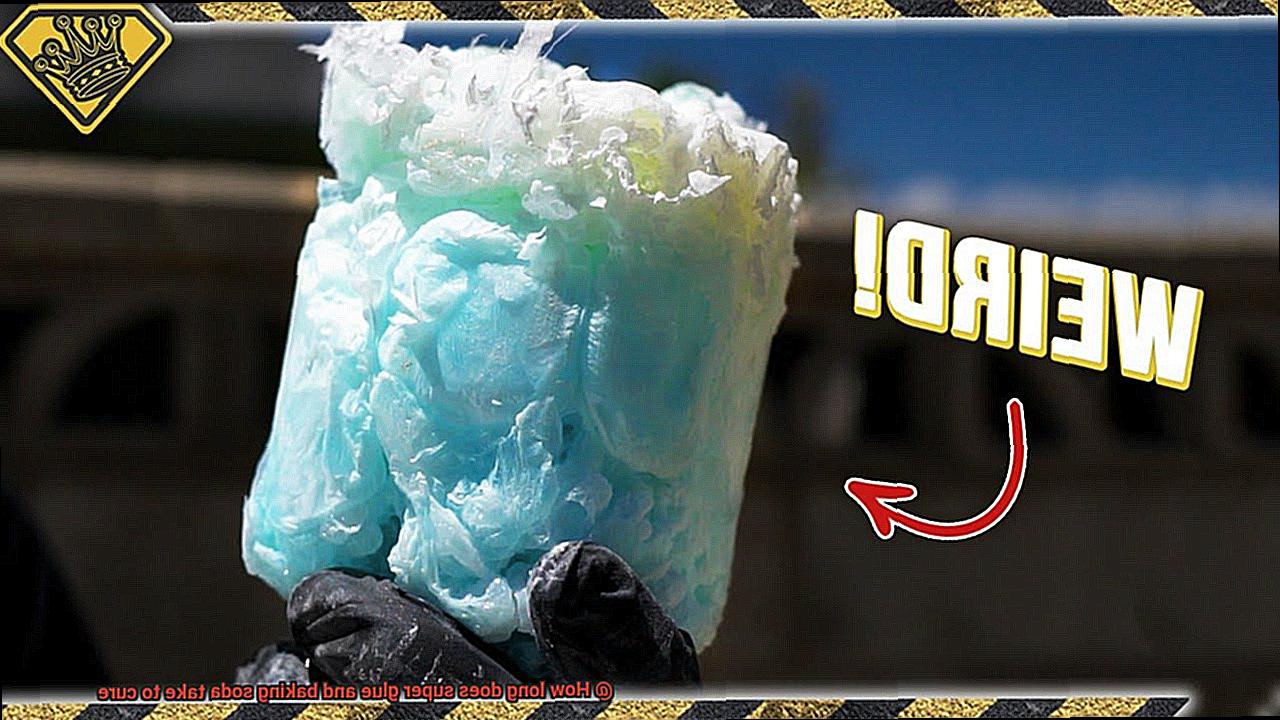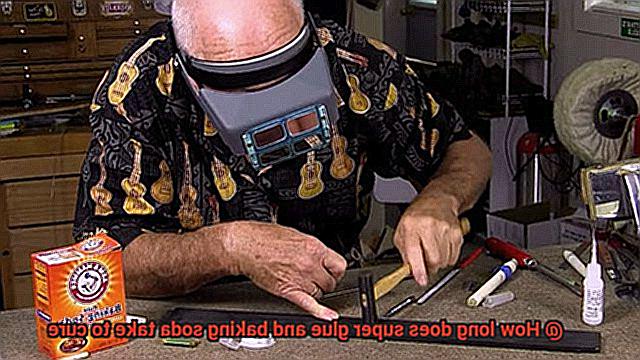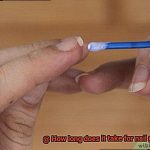Are you tired of waiting for glue to dry when you need to fix something in a hurry? Don’t worry, super glue and baking soda might just be your knight in shining armor. This DIY hack has been hailed as a lifesaver by many, but the question on everyone’s lips is: how long does it take to cure?
Let’s start by delving into the science behind this powerful combo. Super glue, also known as cyanoacrylate glue, bonds with moisture to create an instant hold – which is why it sticks so stubbornly to your skin. But when combined with baking soda, the curing process is accelerated due to the latter’s catalytic properties. The baking soda absorbs moisture from the glue and hardens quickly, creating a strong and durable bond.
So how long does it take for this magic mixture to cure? The answer is not straightforward since it depends on the amount of glue and baking soda used. Generally speaking, smaller projects will cure within 5-10 seconds while larger ones may require several minutes.
If you’re searching for a quick and cost-effective solution that gets the job done efficiently, then super glue and baking soda are definitely worth considering. Say goodbye to frustrating waiting times and hello to speedy fixes that won’t break the bank.
What is Super Glue and Baking Soda?
Contents
- 1 What is Super Glue and Baking Soda?
- 2 How Does the Curing Process Work?
- 3 Factors That Affect Curing Time
- 4 Tips for Applying Super Glue and Baking Soda
- 5 Pros and Cons of Using Super Glue and Baking Soda
- 6 Common Uses for Super Glue and Baking Soda
- 7 Safety Precautions When Using Super Glue and Baking Soda
- 8 Alternatives to Super Glue and Baking Soda
- 9 Conclusion
Super glue, also known as cyanoacrylate adhesive, is a fast-drying, clear adhesive that bonds materials such as metal, plastic, and wood. Baking soda, on the other hand, is a versatile powder commonly used in cooking and baking.
When these two household items are combined, they create a powerful chemical reaction that creates an incredibly strong bond. This technique is particularly useful for filling gaps and cracks in materials like wood or plastic. It’s also great for DIY projects such as repairing broken items or creating custom molds.
However, not all super glue brands will work with baking soda. It’s crucial to test the combination on a small area before using it on a larger project to ensure success. The curing time can vary depending on the amount of glue and baking soda used, as well as environmental conditions. Typically, the mixture can take anywhere from a few seconds to a few minutes to fully cure.
For porous materials like wood or ceramics, multiple layers of the mixture may be necessary for a strong bond. This can extend the curing time as each layer needs to dry before applying another.
While super glue and baking soda are a quick fix, they’re not recommended for situations where high strength is required. They’re best suited for repairing small household items or for temporary fixes until a permanent solution can be found.
How Does the Curing Process Work?
It all comes down to the curing process, which is a chemical reaction between the two substances. As an expert in this field, let me guide you through the fascinating process.
When super glue is applied to a surface, it reacts with the moisture in the air and begins to polymerize, forming a hard, solid bond. However, this process can take some time, especially if the surface is porous or the humidity level is low. That’s where baking soda comes in as a catalyst. By speeding up the polymerization reaction, baking soda causes the glue to harden quickly.
But that’s not all – when baking soda is added to super glue, it creates an exothermic reaction, generating heat that further accelerates the curing process.
This powerful combination of super glue and baking soda can bond even the toughest materials together within seconds.
However, it’s important to note that while the bond may start to harden within seconds, it can take several minutes or even hours for it to reach its maximum strength and durability. The amount of glue applied, humidity level, and type of surface being bonded can all affect the curing time.
That’s why it’s recommended to wait at least 24 hours before subjecting the bond to any stress or load. This will ensure that the bond has fully cured and reached its maximum strength. Additionally, using too much baking soda can actually weaken the bond, so it’s best to use it sparingly.
Factors That Affect Curing Time
Then, let me share with you my expertise on the factors that affect curing time.
Firstly, the amount of glue used is crucial. Using too much glue can cause it to take longer to dry, while using too little may not provide sufficient bonding. Finding the perfect balance will ensure that your bond is strong and dries faster.
Temperature and humidity also play a significant role in the curing time of super glue and baking soda. High temperatures and low humidity can cause the glue to dry out too quickly, leading to poor bonding, while low temperatures and high humidity can slow down the curing process, leading to extended drying times. It’s important to consider the environment before starting your project.
The surface material being bonded can also affect the curing time. Some surfaces may be more porous than others, which may cause the glue to soak in and take longer to dry. Ensure that you choose the appropriate amount of glue depending on the type of surface material.
Different types of super glue have different curing times. From fast-drying super glues that cure in seconds to other types that may take minutes or even hours to dry completely, it’s essential to select the right type based on your bonding needs.
The thickness of the layer of glue applied can also impact its curing time. Thicker layers will take longer to dry than thinner layers. To achieve a faster curing time, ensure that you apply an even layer of glue.
Lastly, moisture can interfere with the bonding process of super glue and baking soda, leading to extended curing times. Before applying the glue, ensure that the surface is dry.
Tips for Applying Super Glue and Baking Soda
If you’re looking to fix broken household items on a budget, the super glue and baking soda method could be your saving grace. However, applying this technique requires some precision and care. Here are some tips and techniques to ensure a strong bond:
Clean and dry surfaces
Before applying the glue, make sure the surfaces are clean and dry. Any dirt or moisture can affect the bonding process. Use a cloth or paper towel to wipe away any debris.
Use a small amount of super glue
Super glue is a powerful adhesive, so less is more when applying it. Applying too much glue can lead to excess buildup, which can compromise the strength of the bond.
Sprinkle baking soda on the glued surface
After applying the super glue to one surface, sprinkle a small amount of baking soda over it. The baking soda acts as a filler, helping to strengthen the bond and create a more solid surface.
Apply pressure
Press the two surfaces together firmly for at least 30 seconds. This will help to ensure that the bond is strong and secure. You can use clamps or heavy objects to hold the surfaces together while they bond.
Wait for it to dry
Depending on the amount of super glue used, it can take anywhere from a few minutes to an hour for the bond to fully cure. It’s important to wait until the bond is completely dry before using or manipulating the glued object.
Be safe
Super glue bonds quickly and can be difficult to remove from skin. Wear gloves or use some type of barrier between your skin and the glue in case of accidental contact.
Pros and Cons of Using Super Glue and Baking Soda
You might want to consider using the dynamic duo of super glue and baking soda. This powerful combination has become increasingly popular among DIY enthusiasts for its quick and strong bonding capabilities. However, like any other solution, it has its pros and cons.
Firstly, let’s talk about the pros of using super glue and baking soda. Firstly, the bond created by this mixture is incredibly strong, making it ideal for repairing items that need to be fixed quickly. Secondly, it is cost-effective compared to other types of adhesives, which makes it an excellent solution for budget-conscious DIYers. Thirdly, it’s versatile and can be used to fix a wide range of items including plastic, metal, wood, ceramics, and more.
Despite its numerous advantages, there are some cons to using super glue and baking soda. For one, mixing the two can be a messy process that can make application difficult. Additionally, super glue contains cyanoacrylate which can cause skin irritation or even chemical burns if not handled carefully. Hence, wearing gloves while using this adhesive is necessary. Finally, once applied, the bond sets quickly leaving only a short window of time for adjustment.
In conclusion, while there are some downsides to using super glue and baking soda, the benefits outweigh them in most cases. The combination of quick application time, strength, versatility, and cost-effectiveness make it an excellent choice for many DIY projects. It is important to apply this adhesive carefully and take precautions to avoid any potential health hazards.
Here’s a quick list of the pros and cons of using super glue and baking soda:
Pros:
- Quick and strong bond
- Cost-effective
- Versatile
Cons:
- Messy application
- Health hazards
- Limited time for adjustment
Common Uses for Super Glue and Baking Soda
If you’re looking for a game-changing bonding solution for your DIY projects, look no further than the powerful combo of super glue and baking soda. As an expert on this topic, I can attest to the strength, versatility, and cost-effectiveness of these two materials.
One of the most impressive aspects of super glue and baking soda is their ability to repair cracks or holes in objects made of plastic, metal, or wood. This process is as easy as it is effective: simply apply a small amount of super glue to the damaged area and sprinkle baking soda on top, allowing it to absorb the glue and create a hard surface that can be sanded or painted over. This technique is particularly useful for fixing car bumpers, toys, and furniture.

And that’s just the beginning. These materials are also ideal for creating custom molds or casts. By mixing them together, you can create a thick paste that can be molded into any shape you desire. Once it dries, the resulting cast will be strong and durable – making it perfect for hobbyists who create miniature models or sculptures.
But wait, there’s more. Super glue and baking soda are also perfect for fixing loose hinges or screws. Simply apply a small amount of super glue to the area around the screw or hinge and sprinkle baking soda on top – the resulting mixture will harden and provide additional support to the screw or hinge.
And the versatility doesn’t stop there. These materials are also great for sealing gaps around windows or doors, repairing cracked tiles in bathrooms or kitchens, and even creating custom jewelry pieces.
However, as with any DIY project, it’s important to use these materials carefully. Messy application and health hazards are possible if not used correctly. Additionally, once applied, there is limited time for adjustment before they become permanently bonded.
Safety Precautions When Using Super Glue and Baking Soda
Before you dive in, it’s crucial to know the essential safety precautions to avoid any accidents or injuries.
First things first, protect yourself by wearing gloves and protective eyewear. Super glue is a potent adhesive that can bond skin, eyes, and other body parts together if not handled with care. Baking soda can also cause respiratory problems if inhaled in large quantities, so make sure to work in a well-ventilated area to avoid inhaling any fumes.
To ensure a successful repair job, always read and follow the instructions on the label carefully. Don’t be tempted to use more than the recommended amount of super glue or baking soda, as overuse can result in an overly strong bond that may be difficult to remove.
In case of accidental skin contact, don’t pull or force the skin apart as this can cause further damage. Instead, soak the affected area in warm soapy water and gently peel the skin apart. If you accidentally get super glue in your eye, seek immediate medical attention.
Lastly, make sure to store your super glue and baking soda out of reach of children and pets. These powerful adhesives should be used with caution and kept in a safe place when not in use.
Alternatives to Super Glue and Baking Soda
There are plenty of alternatives to these trusty adhesives that can get the job done just as well.
Let’s start with super glue. While it’s undoubtedly a fantastic adhesive that can bond almost anything together, sometimes you need to try a new approach. Enter epoxy glue. This two-part adhesive requires mixing before use, but once mixed, it sets quickly and dries to a strong finish that can be sanded or painted over. Another option is hot glue, which is a go-to for crafting enthusiasts. The adhesive dries quickly and can be easily removed with a solvent or by heating it up again.
Now, what about baking soda? If you don’t have any on hand, don’t worry. Cornstarch is an excellent substitute. When combined with water, it creates a paste that can be used to fill gaps or cracks. The paste dries hard and can be sanded down if needed. Toothpaste is another surprising alternative – it contains baking soda as one of its main ingredients. Toothpaste can be used to fill small cracks or holes and dries quickly.
But wait, there’s more. Did you know that there are natural adhesives that can be used instead of super glue? For example, tree sap or resin can be used as a natural adhesive for woodwork. Beeswax is another excellent option for small projects.
FNQSa3H_E1Q” >
Conclusion
In conclusion, the super glue and baking soda combination is a DIY enthusiast’s dream come true. This powerful adhesive duo can bond materials together in a matter of seconds, making it an excellent choice for quick fixes and household repairs alike.
However, it’s important to exercise caution when using super glue as it can bond skin or other body parts together if not handled properly. Wearing gloves and protective eyewear should be a top priority when working with this potent adhesive.
The curing time of the mixture may vary depending on the amount of glue and baking soda used. Smaller projects will cure within 5-10 seconds while larger ones may require several minutes. But once applied, there is limited time for adjustment before they become permanently bonded.
While super glue and baking soda have their advantages, mixing these two substances can be messy. If you’re looking for alternatives, epoxy glue or hot glue are equally strong options that provide a reliable hold. Cornstarch or toothpaste can also be used as substitutes for baking soda in a pinch.
Overall, super glue and baking soda are cost-effective solutions that get the job done efficiently. However, it’s essential to use caution when handling these powerful adhesives to avoid any unwanted mishaps.






